Q: How can you tell we're a dedicated bunch?
A: Yesterday we'd already received the first consignment of
this . . .
this . . .
. . . and five of our members still showed up! That was two more than my most optimistic prediction.
We have two recorded games to choose from this week, both involving Steve Black, an entirely self-taught player whose unconventional (OK, I'll come right out and say it: weird) openings belie an opportunistic eye that often reverses his fortunes for the better in the middlegame and endgame. The second game was against Steve McWhirter, but as tempting as it is to post a "Steve vs. Steve" matchup, that game had to be adjourned at 9 PM so that we could all get home without killing ourselves on the way. Instead, here's the complete first game.
W.Koester–S.Black
Route 20 Chess Club
Freeport, Illinois, Dec. 8, 2009
1.c4 Nf6 2.Nf3 d6 3.g3 Bg4 4.Bg2
Bill plays Bill's Opening. In other breaking news, salt is salty.
4...d5 5.Nh4
5.Ne5 threatens an exchange on g4, removing the guard from the d5 center pawn. Black must then retreat his bishop, giving white better development.
5...e6
Supports d5 and closes off f5. But it also has a drawback: It traps the g4-bishop. 6.h3 Bh5 7.g4 would have driven the bishop over the precipice.
6.Qb3 Qc8?
Steve could have had an advantage with 6...Nc6 7.f3 (7.Qxb7 Nd4 8.0-0 Bxe2 (not 8...Nxe2?! 9.Kh1) 9.cxd5 Bc5 is a winning advantage for black) Bh5 8.0-0.
7.cxd5
7.h4 is much better, and still a possibility.
7...g5??
This invites white to keep munching his way through black's pawns, uncovering a nasty tactic (8.dxe6 Qxe6 (8...fxe6 9.Bxb7!) 9.Qxe6+ Bxe6 10.Bxb7). 7...exd5 is a necessary answer. Black needn't worry about his pawn -- white's queen can't retake it, and his fianchettoed bishop is too valuable a piece to exchange for a knight.
8.Nf3??
Considering that Bill often follows his opening with pressure on b7, it's particularly disappointing that he missed the value of 8.dxe6.
8...Nxd5??
Recapturing with the wrong piece. That knight had a job to do, and Bill takes advantage of its absence.
9.Qa4+ Qd7 10.Qxg4 h6 11.Ne5 Qd6 12.Qd4
12.Nc3!? would go after black's centralized knight and dare him to do anything about it.
12...Bg7 13.Qa4+ Nc6 14.Nxc6 Qxc6 15.Qxc6+ bxc6
Despite his lack of development, which he can catch up on easily, and Steve's central knight outpost, Bill's advantage goes far beyond his extra piece. Steve's doubled c-pawns are sitting ducks. Bill has a comfortable square for his own knight on c4, and his pawns are poised to storm the kingside. Which is why his next few moves are confusing.
16.Bxd5 cxd5
Far from inconveniencing Steve, this exchange actually takes the pressure off.
17.Nc3 Ke7 18.Nb5
Instead of 18.b3, securing the b-file against ...Rab8. Bill's advantage is now less than his extra piece should give him.
18...c6? (18...Rab8 was strategically better) 19.Nc7??
And with this strange "forward retreat," Bill's advantage is almost gone. If Steve plays correctly, that knight will die.
19...Rac8 20.Na6
Steve has the opportunity to make a subtle move here that will really ruin Bill's day. Can you find it? (Highlight to reveal answer.)
20...c5! 21.d4 Bxd4 leaves the knight with no way out.
Alas for Steve, he didn't find it, and Bill reasserted his material advantage.
20...Bd4?? 21.e3 Bb6 22.b3 c5 23.Ba3 Rc6 24.Rc1 Rhc8
Whereupon Bill made a mystifying choice:
25.Bxc5+ Bxc5 26.Nxc5 Rxc5 27.Rxc5 Rxc5
. . . and the extra bishop turns into an extra pawn. Looks like setting off the fireworks on c5 wasn't worth it -- or was it? The weird thing is, 25.Nxc5! Bxc5 26.Rxc5 does work, even though you'd expect the end result to be the same. Here's the difference:
The left-hand diagram is the actual game after 25.Bxc5+ Bxc5 26.Nxc5. The right-hand diagram is the variation 25.Nxc5! Bxc5 26.Rxc5. The difference is that if black recaptures with 26...Rxc5 in the variation, his rook is in a pin, which white can exploit with 27.d4!. Black therefore needs to move his king off the diagonal, giving white the extra tempo to play 27.Rxc6.
Wicked, huh?
28.0-0
Unfortunately for Bill, he no longer has the luxury of castling -- he has to play 28.Kd1 to prevent Steve from invading the seventh rank with his rook. Going into the endgame, the game is now even.
28...Rc2 29.d4 Rxa2 30.Rc1 f5 31.Rc7 Kf6 32.b4 a6 33.Ra7 Rb2 34.Rxa6 Rxb4 35.Kg2 g4 36.Ra8 Rb7 37.Rh8 Kg6 38.h3 h5 39.Re8 Kf6 40.hxg4 hxg4 41.Rh8 Rg7 42.Rh6+ Ke7 43.Kf1 Kd6 44.Ke2 Ra7 45.Kf1 Ra1+ 46.Kg2 Ra8
Since Steve's rook is having all the fun, Bill starts a several-move sequence to work his own rook loose.
47.Rh7 Re8 48.Ra7 e5 49.Ra6+ Kd7 50.Ra5 Kc6 51.Rc5+ Kd6
A very happy home for that rook. But now what?
Black is threatening 52...exd4 53.exd4, after which he'll move his rook to e4 or c8 and attack white's divided pawns. Bill needs to back his rook off to give it maneuvering room. Instead, he plays a pawn break that would have been marvelous earlier (say, at move 42 or 48) but now no longer works.
52.f3?! gxf3+ 53.Kxf3+ exd4 54.exd4 Re4 55.Ra5 Rxd4 56.Ra6+ Ke5 57.Ra1 Re4 58.Ra5 Rg4 59.Ra7 Kd4 60.Ra4+ (60.Rf7 was a great missed opportunity to even the score again) Ke5 (60...Kc3 would have exploited white's mislocated rook) 61.Rf4??
This is such a crucial position, I'm givin' it to you extra-large.
I'd been recording this game while Steve McWhirter and Monica Vorass played a game of their own. By this time they were done, and we were all watching Bill and Steve's endgame with keen interest. Naturally, we were scribbling notes to each other about what moves we thought they ought to play. I had a brain-flash here and wrote "d4!" on the back of my notepad -- the pawn gets a free pass because of the g4-rook's X-ray defense. But there's an even better move that wins the game in one blow. What is it? (Highlight to reveal answer.)
61...Rxf4+!! 62.gxf4+ Kd4 and white, in zugzwang, is forced to make the unappetizing choice between abandoning the defense of his last pawn and giving black's d-pawn a wide-open lane to promotion.
Black has no other move that even begins to compare with the might of 61...d4! or 61...Rxf4!!.
The actual game finished up thusly:
61...Rg5 62.g4?? (62.Ra4 would have maintained a semblance of balance) fxg4+ (62...Rxg4! achieves the same result, but with more certainty) 63.Rxg4 (Bill could have wriggled out with 63.Kg3) Rxg4 64.Kxg4 Ke4 0-1


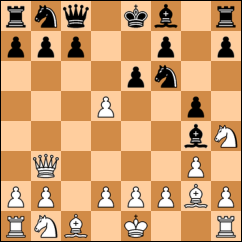
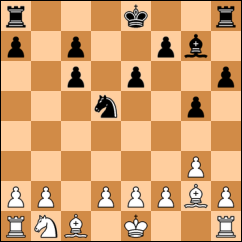
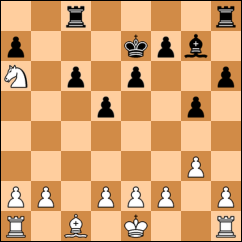
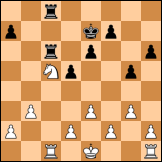
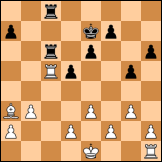
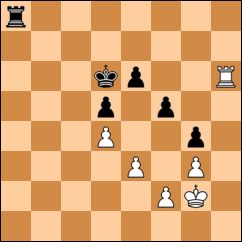
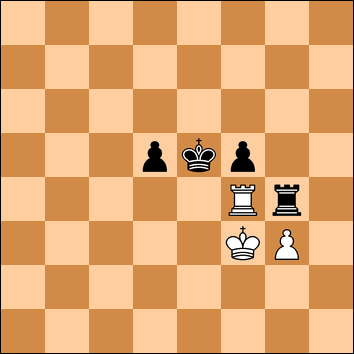



0 comments:
Post a Comment